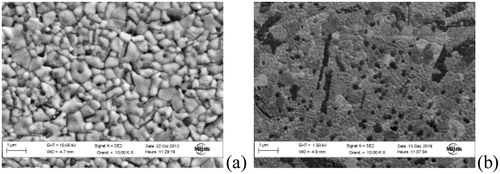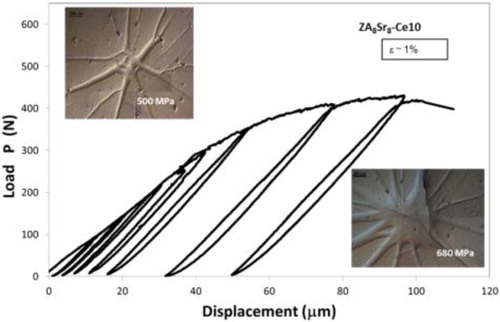1. Introduction
More than 40 years ago, Garvie et al. (Citation1975) have shown that the transformation of metastable tetragonal (t) zirconia grains towards the monoclinic (m) symmetry could be at the origin of a very powerful strengthening mechanism. This work led to considering zirconia-based systems as the “ceramic steels” of the future, based on strong values of mechanical resistance and toughness reported. However, since then, almost only brittle yttrium-doped zirconia (3 mol.% Y2O3 or 3Y-TZP) has been developed for industrial applications, including medical devices. Therefore, to design devices using 3Y-TZP ceramics, statistical approaches of failure are required and issues associated with the spontaneous transformation of zirconia in the presence of water (phenomenon known as “aging” or Low Temperature Degradation LTD) can compromise implants durability (Chevalier et al. Citation2009). Consequently, the enthusiasm and promises expected after Garvie’s et al. (Citation1975) work have almost faded into oblivion, rather due to the development of only brittle 3Y-TZP and not to the potentialities of very transformable and ductile zirconia, such as Ce-stabilized ones (Yu and Shetty Citation1990).
The excellent mechanical properties of 3Y-TZP combined with their superior aesthetics and biocompatibility features allow their use in a number of structural biomedical applications. Particularly, the high strength (>1200 MPa) (Fisher and Stawarczyk Citation2007) and its translucency are very appreciated in the dental field (Denry and Holloway Citation2010). However, the LTD leading to a loss of strength and Y-TZP micro-cracking need to be seriously considered as it was the responsible of the failure of an important number of implanted hip femoral heads (Prozyr®) and of the ban on using 3Y-TZP in the orthopaedic field. Therefore, research work are now focusing on alternative zirconia-based materials to Y-TZP, especially for dental implants applications in which the translucency is less important but for which a perfect stability and long lifetime should be insured. Within this framework, ceria-stabilized zirconia (Ce-TZP) appears as a promising candidate thanks to its low susceptibility to aging and its excellent fracture toughness. However, these Ce-TZP attractive properties are countervailed by its low strength (500 MPa) that still prevents its use in structural biomedical applications. In order to overcome this problem, we have recently developed a new “stable” ceria-doped zirconia composite containing two second phases (Al2O3 and SrAl12O19) through a simple but reliable surface-coating route (Palmero et al. Citation2015). Here, the mechanical properties of such multi-phasic zirconia-based ceramics and their use in ceramic dental implants are discussed and compared to Ti-based and 3Y-TZP materials.
2. Methods
At the lab-scale, a commercial 10 mol.% Ceria-stabilized zirconia powder (Daiichi, Japan) was dispersed in distilled water and Al, Sr and Ce nitrates were added as precursors. After drying, the powder coated was thermally treated to obtain a tri-phasic zirconia-8vol.% alumina-8vol% strontium aluminate powder (ceria content between 10.0 and 11.5 mol.%). Ceramics were slip-casted or pressed and sintered (1350–1450 °C/1h) to reach 99.9% of the theoretical density. Four stabilization degrees were investigated and different mechanical tests were carried out (biaxial piston-on-3balls and 3balls-on-3balls, Single-edge V-notched beam, 4-point bending and fatigue) in order to investigate the mechanical behaviour of these composites. Biological performances in vitro and in vivo were also performed. At the industrial-scale, wet chemical synthesis and spray-drying of composite powders were carried-out (Daiichi, Japan). Ceramics produced by cold isostatic pressing (3000 bars) and conventional sintering (1350–1450 °C/1h) were machined applying CAD-CAM procedures (bars and dental implants).
3. Results and discussion
The microstructural features of Ce-TZP based composites (ZA8Sr8-Ce11) prepared at the lab and industrial scales and sintered at 1400 °C-1h are shown in . As the synthesis and processing are not the same, grain sizes were modified, especially bigger Sr-aluminates were crystallized. Therefore, the optimal content of ceria needs to be adapted to the microstructural features ().
Figure 1. Microstructure of ZA8Sr8-Ce11 composites prepared (a) at the lab and (b) at the industrial scale.

Table 1. Properties of optimized materials prepared at the laboratory (Lab) and at the industrial scale (Ind.).
In these ceramics (Ce < 11 mol.%), a certain degree of ductility was observed, especially in very transformable materials.
As shown in , the tetragonal (t) to monoclinic (m) phase transformation starts well-before crack propagation inducing a remarkable plasticity for a ceramic (1%) (Reveron et al. Citation2017). Moreover, these composites remained stable after 50 h of aging accelerated tests, i.e., 150–200 years in-vivo and promising results in terms of bacterial adhesion, biocompatibility and osseointegration have been also obtained.
In the framework of the LONGLIFE and SISCERA European projects, ceramic dental implants were developed using these composites and first prototypes are being tested under relevant conditions (animal models and pre-clinical study).
4. Conclusions
In new developed Ce-zirconia based materials, the well-dispersed alumina particles apply an effective pinning effect on zirconia grain boundaries, making it possible to obtain both fine microstructures and high critical t-m transformation stresses. Simultaneously, the efficiency of the phase transformation toughening is preserved by carefully tailoring the ceria content in the composite. Our study demonstrates that developed Ce-TZP composites are aging-resistant and undergo transformation-induced-plasticity without damage. The predictive nature of the strength (very high Weibull modulus), associated with a ‘‘metal-like” behaviour (ε∼1%), a low sensitivity to fatigue (fatigue limit of more than 90% of the tensile strength) and no LTD gives to Ce-TZP composites an unneglectable advantage over the well-known 3Y-TZP ceramic. These results may re-open the discussion on Ce-stabilized zirconia as the engineering “ceramic steel” material for the coming future. However, at the industrial scale, the most critical point is finding a company able to process kilograms of granules with good pressability.
Additional information
Funding
References
- Chevalier J, Gremillard L, Virkar A, Clarke D. R. 2009. The Tetragonal-monoclinic transformation in zirconia: lessons learned and future trends. J. Am. Cer. Soc. 92(9):1901–1920.
- Denry I, Holloway J.A. 2010. Ceramics for dental applications: a review. Materials. 3(1):351–368.
- Fisher J, Stawarczyk B. 2007. Compatibility of machined CeTZP/Al2O3 nanocomposite and a veneering ceramic. Dent Mater. 23:1500–1505.
- Garvie R.C, Hannink R.H, Pascoe R.T. 1975. Ceramic steel. Nature. 258(5537):703–704.
- Palmero P, Fornabaio M, Montanaro L, Reveron H, Esnouf C, Chevalier J. 2015. Towards long lasting zirconia-based composites for dental implants. Part I: Innovative synthesis, microstructural characterization and in vitro stability. Biomaterials. 50:38–46.
- Reveron H, Fornabaio M, Palmero P, Fürderer T, Adolfsson E, Lughi V, Bonifacio A, Sergo V, Montanaro L, Chevalier J. 2017. Towards long lasting zirconia-based composites for dental implants: Transformation induced plasticity and its consequence on ceramic reliability. Acta Biomater. 48:423–432.
- Yu C.S, Shetty D.K. 1990. Transformation yielding, plasticity and crack-growth-resistance (R-curve) behaviour of CeO2-TZP. J Mater Sci. 25(4):2025–2035.

